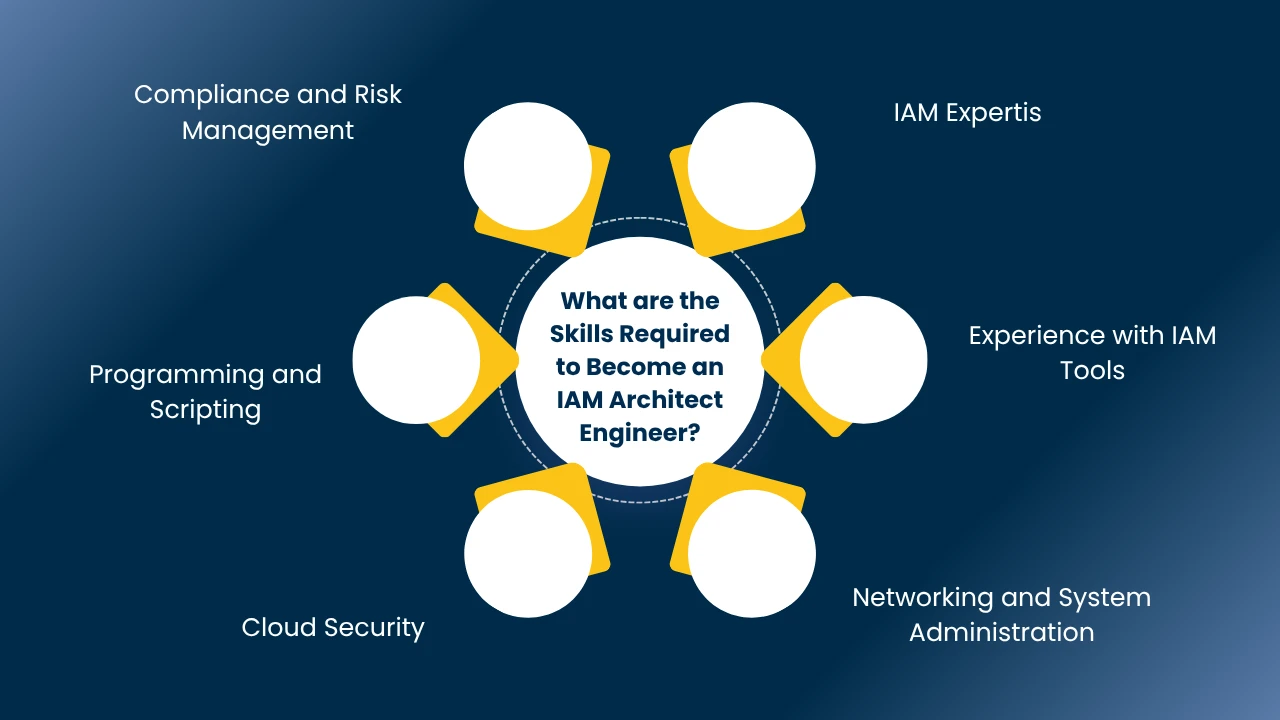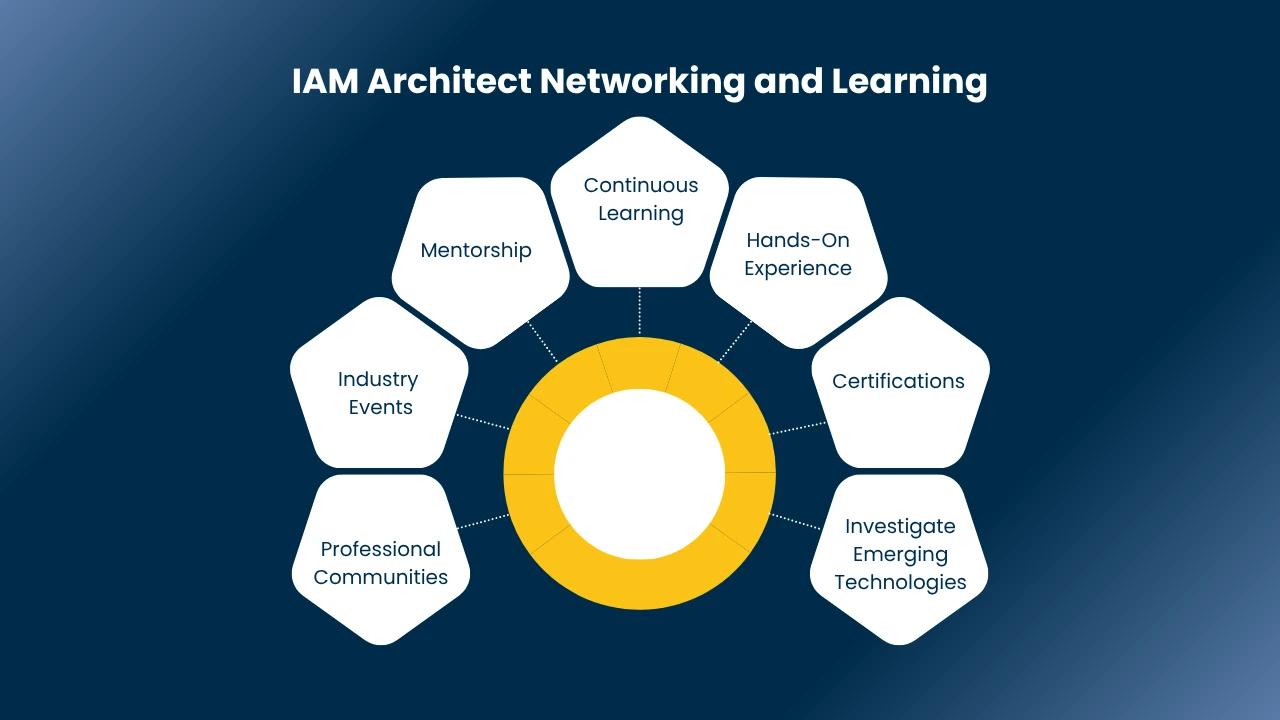IAM Architect: Components, Skills, and Benefits

Being an IAM Architect ranks among the most satisfying career paths in cybersecurity today. As organizations expand and implement sophisticated IT infrastructures cloud, on-site, and hybrid never has the need to manage digital identities and access securely been more pressing. An IAM Architect creates, implements, and runs identity and access structures. It is to protect sensitive assets and provide regulatory compliance.
Furthermore, IAM architect roles and responsibilities require a blend of technical knowledge, strategic planning, and hands-on skills. Whether, you are a fresh graduate or a professional who is interested in cybersecurity specialization. It is essential to understand what it takes to become an IAM architect. Therefore, in this blog, you’ll learn How to become IAM architect in India. Additionally, about the educational requirements, certifications, essential skills, responsibilities, and career advancement opportunities for IAM Architects. Also, find out how Cybersec Trainings can assist you with IAM architect interview questions to achieve the needed skills and certification to advance your career.
What is IAM Architect Education and Certification?
An IAM Architect creates and controls the identity and access management systems that secure an organization’s information and applications. In order to be skilled in this career, one needs to begin with a proper education. IAM architects possess a minimum of a bachelor’s degree in computer science, information technology, cybersecurity, or related fields.
Therefore, this education gives them the basic knowledge in programming, networking, database management, and security principles. However, a degree is not enough. We all know that the ever-changing field of cybersecurity requires ongoing learning and reskilling. Therefore, the industry-certified certifications are essential credentials. Because, it proves that you have the skills and distinguish you in the competitive IAM architect job market.
Most Relevant Certifications for IAM Architects
CISSP (Certified Information Systems Security Professional): This is a widely valued, vendor-independent credential. This certification addresses general security issues, like IAM concepts.
1. CISM (Certified Information Security Manager
Emphasizes security management and governance, suitable for architects who must handle IAM policies.
2. CIAM (Certified Identity and Access Manager)
Identifies IAM best practices and technologies specifically.
3. Vendor-Specific Certifications
Vendors of different IAM solutions apply their own certifications, such as CyberArk Certified Trustee, SailPoint IdentityIQ certification, or Okta Certified Professional. They indicate proficiency in provided platforms.
4. Cloud IAM Certifications
As cloud adoption is increasing at a rapid pace, certifications such as CCSP (Certified Cloud Security Professional) or provider-based IAM certifications (AWS IAM, Azure AD) become crucial.
Also Read: What is the IAM Architect Salary in India & Abroad in 2025
Why Does IAM Architect Certification Matters?
Certifications show your technical competence and dedication to your employers. They also help you in higher pay and better job roles. Additionally, most organizations mandate that their IAM specialists hold certain certifications. Therefore, in order to comply with regulatory frameworks like HIPAA, GDPR, or NIS2.
1. Core Tasks of an IAM Architect
IAM Architects carry out a wide range of fundamental functions. Therefore, this guarantees the secure and efficient management of access rights and identities within an organization.
2. Designing IAM Solutions
Developing detailed IAM system designs that meet business requirements, security, and compliance regulatory demands.
3. Implementation and Deployment
Managing the deployment and installation of IAM platforms and tools either on-premise or in the cloud.
4. Access Governance
Establishing access control policies, role-based and attribute-based access models, and segregation of duties to reduce risk.
5. Risk Assessment
Ongoing examination and mitigation of identity-related risk and vulnerabilities.
6. Integration
Securing IAM systems to integrate safely with other security and IT infrastructure components. It includes, SIEM (Security Information and Event Management), ERP systems, and cloud services.
7. Monitoring and Auditing
Applying monitoring in order to detect unauthorized access and maintain audit trails for reporting compliance.
8. User Lifecycle Management
Automated user provisioning, de-provisioning, and access reviews.
9. Collaboration
In close collaboration with IT, security administrators, and business users in order to find usability vs. security balance.
IAM Architect Experience and Portfolio
Building a strong portfolio and gaining appropriate experience are crucial to becoming an experienced IAM Architect.
1. Experienced Areas to Focus Your Experience
IAM Platforms: Develop hands-on experience using top IAM platforms like SailPoint IdentityIQ, Microsoft Azure AD, CyberArk, BeyondTrust, and Okta. Hands-on experience in installation and maintenance of these tools is greatly appreciated.
2. Authentication and Authorization
Master different techniques like multi-factor authentication (MFA), single sign-on (SSO), federated identity management, OAuth, SAML, and OpenID Connect.
3. Cloud IAM
Develop hands-on skills with IAM in cloud environments (AWS IAM, Azure AD, Google Cloud IAM) as more workloads migrate to the cloud.
4. Identity Governance and Administration (IGA)
Master access certifications, role mining, entitlement management, and compliance controls.
5. Security Standards
Knowledge of security and compliance standards like NIS2, ISO 27001, SOC 2, HIPAA, and GDPR.
6. Automation and Scripting
Automate identity life cycle management processes through scripting languages like PowerShell, Python, or JavaScript.
7. Risk Management
Capability to evaluate and mitigate IAM-associated security risks.
Your portfolio must reflect actual-world IAM projects where you were involved in the design, deployment, or development of identity management procedures. Emphasize challenges encountered, solutions implemented, and quantifiable results such as enhanced security posture or eased access processes. A good portfolio is a great way to prove your ability during job interviews and career advancement discussions.
Also Read: SailPoint IdentityIQ Training in Gurugram: Fees, and Training Duration.
What are the Skills Required to Become an IAM Architect Engineer?
An IAM Architect needs to combine a wide range of technical and interpersonal skills in order to be successful.
Technical Skills
1. IAM Expertise: Strong knowledge of authentication, authorization, federation, identity federation, and user life cycle management.
2. Experience with IAM Tools: Knowledge of SailPoint, CyberArk, Okta, ForgeRock, Azure Active Directory, and related technologies.
3. Networking and System Administration: Familiarity with network protocols, LDAP, Active Directory, and system architecture.
4. Cloud Security: Experience of IAM solution in cloud and hybrid deployment models.
5. Programming and Scripting: Familiarity with Java, JavaScript, Python, and SQL programming languages to enrich IAM flows and implement APIs.
6. Compliance and Risk Management: Familiarity with corresponding regulatory requirements and best practices to manage identity risk.
Business and Soft Skills
1. Communication: Capacity to articulate complicated technical concepts in a straightforward way to non-technical stakeholders and convert business requirements into technical IAM solutions.
2. Problem-Solving: Analytical abilities to detect and resolve IAM problems efficiently.
3. Project Management: Effective management of IAM projects, timelines, and resources. Collaboration: Alignment with cross-functional teams such as IT, security, and business units.
4. Leadership: Management of IAM programs and guiding junior team members.
5. Attention to Detail: Accuracy in policy definitions and access controls.
IAM Architect Networking and Learning
Networking and continuous learning are cornerstones to success in IAM architecture.
1. Professional Communities: Participate in forums and communities like (ISC)², ISACA, or vendor communities like SailPoint or CyberArk forums to interact with peers and experts.
2. Industry Events: Join conferences, webinars, and workshops related to cybersecurity and IAM.
3. Mentorship: Find mentors who have deep IAM experience to guide your career path.
4. Continuous Learning: Read blogs, podcasts, and newsletters to remain current on IAM trends, new technologies, and regulations.
5. Hands-On Experience: Work on labs, simulation projects, and open-source IAM projects.
6. Certifications: Renew and update certifications to remain current.
7. Investigate Emerging Technologies: Research AI-based IAM, Zero Trust architectures, blockchain-based identity management, and cloud-native IAM solutions.
IAM Architect Career Development and Advancement
Demand for qualified IAM Architects will continue to rise as companies are more and more interested in cybersecurity and compliance.
- Build comprehensive knowledge of IT security and IAM tools.
- Gain certifications like CISSP, CISM, and cloud-specific credentials.
- Develop leadership and communication skills to transition into managerial roles.
- Stay abreast of emerging technologies such as Zero Trust Security and AI in IAM.
- Expand expertise into related fields like Privileged Access Management (PAM) or Cloud Security Architecture.
- Engage in speaking engagements and publish articles to establish yourself as an industry thought leader.
- Consider advanced education like a master’s degree in cybersecurity or business administration.
Career progression can lead from IAM Engineer or Analyst roles to senior architect positions, security architects, and eventually Chief Information Security Officer (CISO) roles.
Read More: SailPoint IdentityIQ Jobs: Career Opportunities and Growth
How Cybersec Trainings Can Help IAM Architects Boost Their Career?
Cybersec Trainings offers specialized programs designed to prepare aspiring and experienced IAM professionals for success:
- Comprehensive Curriculum: Covering fundamentals to advanced topics, including hands-on labs with platforms like SailPoint, CyberArk, Okta, and Azure AD.
- Expert Instructors: Learn from seasoned cybersecurity experts who bring real-world experience.
- Certification Preparation: Targeted training for certifications including CISSP, CISM, CIAM, and vendor-specific credentials.
- Career Support: Interview coaching, resume reviews, and job placement assistance.
- Flexible Learning: Online and classroom options to fit your schedule.
- Industry-Relevant Projects: Realistic scenarios to build a strong portfolio.
- Networking Opportunities: Connect with peers and industry professionals through community events and webinars.
Choosing Cybersec Trainings equips you with the knowledge, skills, and credentials to excel as an IAM Architect and advance your cybersecurity career.
Conclusion
The role of an IAM Architect is central to protecting organizational assets in today’s digital landscape. By combining solid education, relevant certifications, practical experience, and continuous learning, you can build a successful and rewarding career in this dynamic field. Cybersec Trainings offers the resources, expert guidance, and community support to help you achieve your goals and become a leader in Identity and Access Management. Whether you’re just starting out or aiming for the next level, investing in your IAM expertise today will open doors to exciting job opportunities and career growth.
Understand how Orbus can help your career!
Speak with an Expert Now!
FAQ's
How to transition to an IAM engineer Job?
Gain foundational IAM knowledge through courses and certifications. Pursue hands-on experience via internships or projects with IAM tools. Network actively and apply for entry-level roles to gain industry exposure.
What are the job requirements for an IAM engineer?
Typically requires a degree in IT or cybersecurity, understanding of IAM principles, experience with IAM platforms, scripting skills, and familiarity with security regulations.
What is an IAM engineer job responsibility?
IAM architect job description includes, manage identity lifecycle, configure access controls, troubleshoot IAM issues, and ensure compliance with policies.
What does an IAM architect do?
Designs and implements IAM strategies, selects and configures tools, manages access governance, and ensures security compliance.
How do I become an IAM specialist?
Pursue relevant education and certifications, gain hands-on experience, and keep up with emerging IAM trends.
How much do IAM principal architects make?
IAM architect salary vary globally. In the US, it ranges from $120,000 to $180,000 annually. In India, it typically ranges from ₹25 to ₹60 lakhs per year.
What qualifications do I need to be a security architect?
A degree in IT or cybersecurity, certifications like CISSP or CISM, practical security experience, and strong communication skills are essential.






